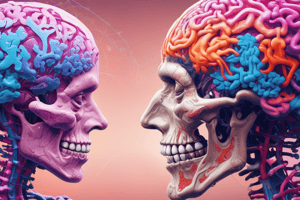Podcast
Questions and Answers
What is the primary cause of the formation of plaques in the brain in Alzheimer's disease?
What is the primary cause of the formation of plaques in the brain in Alzheimer's disease?
- Deterioration of tau function
- Loss of microtubule-binding protein tau
- Excessive phosphorylation of tau
- Abnormal accumulation of longer forms of Aβ (correct)
What is the role of phosphorylation of tau in Alzheimer's disease?
What is the role of phosphorylation of tau in Alzheimer's disease?
- Reducing the expression of tau in neurons
- Causing detachment from microtubules and accumulation into insoluble neurofibrillary tangles (correct)
- Promoting stability and function of tau
- Preventing the formation of neurofibrillary tangles
How is Alzheimer's disease diagnosis made in living humans nowadays?
How is Alzheimer's disease diagnosis made in living humans nowadays?
- Analysis of brain tissue after death
- Comparison with 'non-Alzheimer's disease' individuals
- Postmortem histology examination
- Detection and quantification of Aβ, tau, and neurodegeneration biomarkers (correct)
What was revealed by the study mentioned in the text regarding individuals diagnosed with Alzheimer's disease?
What was revealed by the study mentioned in the text regarding individuals diagnosed with Alzheimer's disease?
What is the range of age at death observed in the participants in the study mentioned in the text?
What is the range of age at death observed in the participants in the study mentioned in the text?
Which of the following is described as a biological domain linked to the development of Alzheimer's disease?
Which of the following is described as a biological domain linked to the development of Alzheimer's disease?
What is the primary implication of genetic risk factors for Alzheimer's disease?
What is the primary implication of genetic risk factors for Alzheimer's disease?
Disruption of which biological domain can have a direct impact on synapse loss and/or dementia?
Disruption of which biological domain can have a direct impact on synapse loss and/or dementia?
What is the influence of different combinations of risk factors on the biological domains involved in the pathogenesis of Alzheimer's disease?
What is the influence of different combinations of risk factors on the biological domains involved in the pathogenesis of Alzheimer's disease?
What is thought to interact and differentially affect sets of biological domains related to Alzheimer's disease?
What is thought to interact and differentially affect sets of biological domains related to Alzheimer's disease?
What is a potential advantage of using iPSC monocultures in studying Alzheimer's disease?
What is a potential advantage of using iPSC monocultures in studying Alzheimer's disease?
What is a limitation of the in vitro human systems mentioned in the passage?
What is a limitation of the in vitro human systems mentioned in the passage?
Which technology was used to generate mouse models carrying LOAD-associated variants in specific genes?
Which technology was used to generate mouse models carrying LOAD-associated variants in specific genes?
What is the primary purpose of developing mouse models carrying novel combinations of genetic variants of LOAD risk?
What is the primary purpose of developing mouse models carrying novel combinations of genetic variants of LOAD risk?
What insight has been provided by the progeny of humanised APOE surrogate mouse lines crossed with humanised MAPT and APP/PSEN1 models?
What insight has been provided by the progeny of humanised APOE surrogate mouse lines crossed with humanised MAPT and APP/PSEN1 models?
Flashcards are hidden until you start studying




